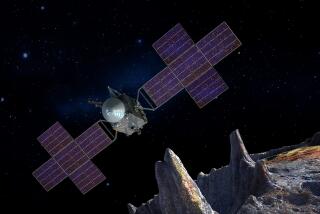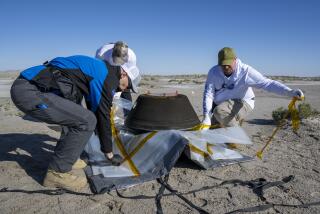Chelyabinsk asteroid smashed glass, burned skin, defied expectations
Planetary scientists weren’t remotely expecting the 62-foot-wide Chelyabinsk fireball to shoot across Russian skies in February -- they’d had their eyes peeled on a much bigger target that missed the Earth by a decent margin, the asteroid 2012 DA14. But this relatively modest, unseen space rock caused a shock wave that shattered countless windows in the city and injured more than a thousand people.
It was the largest asteroid impact on land in more than a century. Researchers are now saying that such impacts, from relatively small asteroids just tens of yards long, might be 10 times more common than we’d thought.
The finding comes from one of three studies published in the journals Nature and Science that provide a much fuller profile of the Chelyabinsk asteroid – both its behavior and its origins. By using camera footage, seismic data and a host of other sources, scientists say they hope to better predict which asteroids are most dangerous and how they will act if they impact Earth or its atmosphere.
“If you want to calculate what happens in other circumstances in future asteroid impacts, you first need to understand Chelyabinsk,” Peter Jenniskens, a research scientist at NASA’s Ames Research Center in Mountain View, Calif., and one of the coauthors of the Science paper, said in an interview. “So Chelyabinsk is now the gold standard, thanks to citizen science. It is now our calibration point. And that’s why it’s really important to figure out what happened.”
Scientists braved Russia’s frigid temperatures in the asteroid’s aftermath to collect what data they could.
“It was good to be there,” Jenniskens said. “We visited 50 villages and talked with people in grocery stores, talked with people on the street, and everybody we talked to had a story to tell.”
When it exploded about 18.5 miles above the ground, the space rock shone 30 times brighter than the sun and sent out so much ultraviolet light that eyewitnesses directly below it developed serious sunburns, Jenniskens said.
It was the largest impact since the 1908 Tunguska impact, caused by a giant asteroid that delivered a blast estimated at 10 to 50 megatons of TNT – at least 20 times more powerful than the Chelyabinsk fireball.
For the Science paper, a team led by Olga Popova of the Russian Academy of Sciences, also studied fragments recovered in the area and determined that the space rock had probably suffered an impact hundreds of millions of years ago that caused shock veins to run through it, weakening its structure. Under the tremendous stress of entering Earth’s atmosphere, the weakened asteroid chunk exploded in midair.
Scientists flocked to Chelyabinsk after the space rock impact. Hundreds of cameras captured the event, making it an ideal chance for some hands-on research, scientists said.
“Clearly it was a once-in-a-lifetime opportunity,” said Peter Brown, a planetary scientist at the University of Western Ontario who led one of the two studies in Nature and worked on both.
The scientists used plentiful video from 400 video cameras (typically dashboard cameras in cars) to characterize the space rock’s impact on our atmosphere. They found that it exploded with the energy of 500 kilotons of TNT – roughly equivalent to a modern nuclear bomb. Fragments rained down as meteorites, including a half-ton behemoth pulled out of Lake Chebarkul.
But for that energy level, the fireball didn’t do nearly as much damage as predicted for a blast that strong. The researchers think this has to do with the space rock’s trajectory – it doesn’t explode in essentially one place, as a bomb does – it’s speeding through the air and unloading that energy as it goes. The angle of entry was also fairly shallow, Brown pointed out, further mitigating the damage.
Current models to predict an asteroid’s behavior when it flies into Earth’s airspace haven’t taken a number of these factors into account. Models based on Chelyabinsk will help researchers find which factors they were missing.
“We need to refine those estimates,” he said.
The scientists also wanted to see how accurate our current telescope-based asteroid trackers were. They used decades of data from infrasound instruments and U.S. government sensors to pull out records of shock waves created by asteroids hitting Earth’s atmosphere. Then they compared it with the telescopic data.
“We should see something like Chelyabinsk every 30 to 40 years rather than every 120 to 140 or so — a factor of three or four more of these impacts than the telescopic data suggest,” Brown said.
The roughly tenfold increased risk reported by Brown’s team could potentially be a slight overestimate, Paul Chodas, a research scientist in the Near Earth Object Program Office at the Jet Propulsion Laboratory in La Cañada Flintridge, said at a NASA news briefing.
But, he added, “there is an apparent discrepancy between the number of impacts in this size range being higher than previously thought … and I think this is exciting new data and more work needs to be done to settle that size discrepancy.”
ALSO:
Half-ton meteorite from Chelyabinsk fireball pulled from Russian lake
Trick or treat? LA grandma says kids picked fruity candy in Halloween experiment
Trees recruit army of ants to protect against invading leaf-eaters







